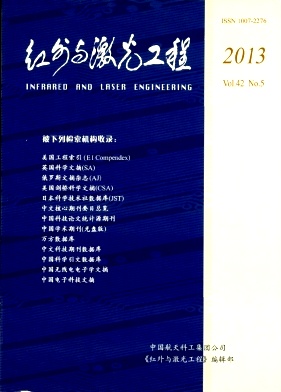|
[1]
|
|
|
[2]
|
Leordeanu M, Hebert M. A spectral technique for correspondence problems using pairwise constraints[C]//International Conference of Computer Vision, 2005: 1482-1489. |
|
[3]
|
Bai Lianfa, Han Jing, Zhang Yi, et al. Registration algorithm of infrared and visible images based on improved gradient normalized mutual information and particle swarm optimization[J]. Infrared and Laser Engineering, 2012, 41(1): 248-254. (in Chinese) |
|
[4]
|
|
|
[5]
|
Liu Xingmiao, Wang Shicheng, Zhao Jing. Infrared image moving object detection based on image block reconstruction[J]. Infrared and Laser Engineering, 2011, 40(1): 176-180. (in Chinese) |
|
[6]
|
|
|
[7]
|
|
|
[8]
|
Minsu C, Jungmin L, Kyoung M L. Reweighted random walks for graph matching[C]//European Conference on Computer Vision, 2010: 492-505. |
|
[9]
|
|
|
[10]
|
Christmas W J, Kittler J, Petrou M. Structural matching in computer vision using probabilistic relaxation[J]. IEEE Transactions on Pattern Analysis and Machine Intelligence, 1995, 17(8): 749-764. |
|
[11]
|
|
|
[12]
|
Wang Xin, Zhao Chunhui, Zhang Zhaozhu. Research of improved simulated annealing algorithm in image registration[J]. Applied Science and Technology, 2006, 33(1): 10-12. (in Chinese) |
|
[13]
|
|
|
[14]
|
Pan Linqiang, Prez-Jimnez M J. Computational complexity of tissue-like P systems[J]. Journal of Complexity, 2010, 26(3): 296-315. |
|
[15]
|
Ishdorj T, Leporati A, Pan Linqiang, et al. Deterministic solutions to QSAT and Q3SAT by spiking neural P systems with pre-computed resources[J]. Theoretical Computer Science, 2010, 411(25): 2345-2358. |
|
[16]
|
|
|
[17]
|
Zhang Xingyi, Wang Shuo, Niu Yunyun, et al. Tissue P systems with cell separation: attacking the partition problem[J]. Science China Information Sciences, 2011, 54(2): 293-304. |
|
[18]
|
|
|
[19]
|
Nishida T Y. An application of P-system: A new algorithm for NP-complete optimization problems[C]//Proceedings of 8th World Multi-Conference on Systemics, Cybernetics and Informatics, 2004: 109-112. |
|
[20]
|
|
|
[21]
|
Huang Liang, Suh I H. Controller design for a marine diesel engine using membrane computing[J]. International Journal of Innovative Computing Information and Control, 2009, 5(4): 899-912. |
|
[22]
|
|
|
[23]
|
|
|
[24]
|
Huang Liang, Sun Lei, Wang Ning, et al. Multiobjective optimization of simulated moving bed by tissue P system[J]. Chinese Journal of Chemical Engineering, 2007, 15(5): 683-690. |
|
[25]
|
|
|
[26]
|
Zhang Gexiang, Gheorghe M, Wu C Z. A quantum-inspired evolutionary algorithm based on P systems for knapsack problem[J]. Fundamenta Informaticae, 2008, 87(1): 93-116. |
|
[27]
|
P?un G. Tracing some open problems in membrane computing[J]. Romanian Journal of Information Science and Technology, 2007, 10(4): 303-314. |
|
[28]
|
|
|
[29]
|
Tang Jin, Jiang Bo, Luo Bin. Graph matching based on graph histogram and path similarity[J]. Journal of Computer-Aided Design Computer Graphics, 2011, 23(9): 1481-1489. (in Chinese) |









 DownLoad:
DownLoad: